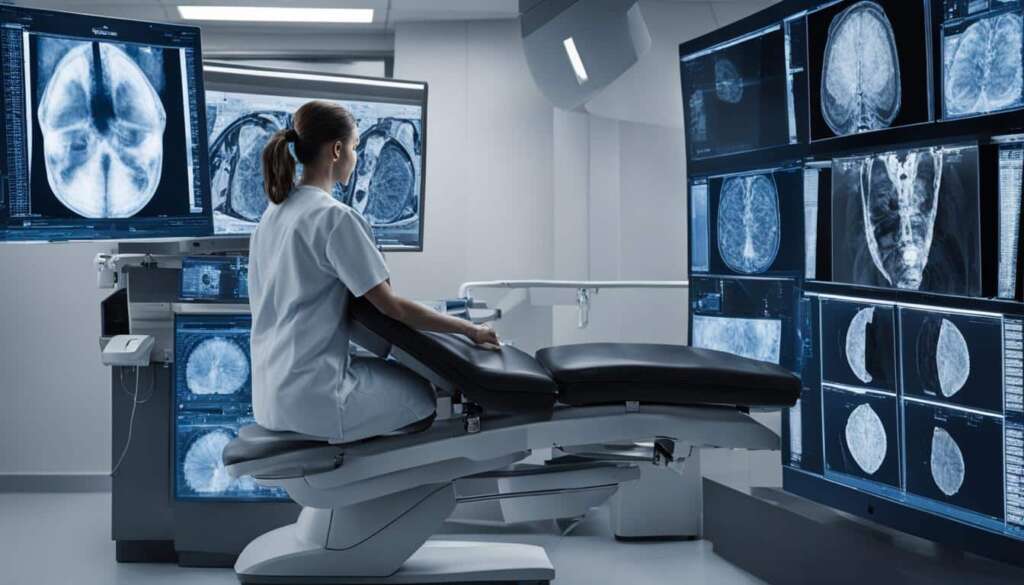Table of Contents
The field of medical imaging relies heavily on advanced technology to obtain accurate and detailed images for diagnosis and treatment. One important aspect of this technology is the DICOM standard, which stands for Digital Imaging and Communications in Medicine. DICOM serves as a data interchange protocol and digital image format that enables seamless communication and interoperability between various medical imaging devices and systems.
DICOM provides a standardized framework for the exchange and management of medical images and related information. It encompasses a wide range of applications, including network image management, interpretation, print management, and storage media management. By adhering to the DICOM standards, vendors and manufacturers ensure that medical imaging devices from different brands can communicate efficiently, allowing healthcare professionals to access and analyze images from anywhere in the world.
The DICOM protocol uses the Transmission Control Protocol and Internet Protocol to enable secure image exchange over the internet. It offers composite and normalized services for image storage, retrieval, query, and transfer. The DICOM Standard acts as a blueprint for information structures and procedures, promoting consistency and interoperability between diverse imaging systems.
With DICOM’s wide implementation across various medical imaging devices, such as X-ray, CT, MRI, and ultrasound machines, it has become the international standard for digital image communication in medicine. Its evolution over the years has transformed clinical medicine by replacing film-based imaging with fully digital workflows, enabling advanced diagnostic capabilities and improving patient care.
In the following sections of this article, we will delve deeper into the importance of DICOM in medical imaging, its working principles, and its evolution as a standard for digital image communication in the field of medicine.
Why is DICOM Important in Medical Imaging?
DICOM plays a crucial role in medical imaging due to its significance in ensuring efficient care, seamless communication, and reliable interoperability of systems utilized in the process of producing, storing, sharing, displaying, sending, querying, processing, retrieving, and printing medical images.
By adhering to the DICOM standards, manufacturers of imaging equipment and imaging information systems enable the integration of medical imaging devices from various vendors. This integration allows for easier access to images and reports for physicians, enabling them to make accurate diagnoses regardless of their geographical location. With the use of DICOM, healthcare providers can swiftly exchange medical images and related data, eliminating the need for film-based images and physical storage.
DICOM provides a standardized format for exchanging and storing patient data and images, ensuring consistency and compatibility across different medical imaging systems. This standardized approach enhances interoperability and streamlines the process of sharing critical information, contributing to efficient and effective patient care.
“DICOM’s importance in medical imaging lies in its ability to facilitate seamless communication and integration of medical imaging devices, enabling physicians to make accurate diagnoses regardless of geographical location, and eliminating the need for physical storage of medical images.”
Benefits of DICOM in Medical Imaging:
- Enables easy access to medical images and reports for physicians, regardless of their location.
- Eliminates the need for physical storage of medical images and related data.
- Facilitates seamless communication and integration of medical imaging devices from multiple manufacturers.
- Standardizes the format for exchanging and storing patient data and images.
- Enhances interoperability and efficient sharing of critical information between different imaging systems.
- Promotes efficient care and streamlined workflows in medical imaging.
| Benefit | Description |
|---|---|
| Easy Access to Images | Physicians can access medical images and reports from anywhere in the world, enabling them to make diagnoses efficiently and effectively. |
| Elimination of Physical Storage | Medical images and related data can be securely stored digitally, eliminating the need for film-based images and physical storage facilities. |
| Seamless Communication and Integration | Vendors can integrate medical imaging devices from multiple manufacturers, allowing for seamless communication and data exchange. |
| Standardized Data Exchange | DICOM provides a standardized format for exchanging and storing patient data and images, ensuring compatibility and consistency. |
| Enhanced Interoperability | DICOM promotes interoperability between different imaging systems, simplifying the sharing of critical information among healthcare providers. |
| Efficient Care | With streamlined workflows and standardized data exchange, DICOM enables efficient care delivery in medical imaging. |
How Does DICOM Work in Medical Imaging?
DICOM, or the Digital Imaging and Communications in Medicine, operates on a robust protocol that facilitates the exchange of messages between DICOM application entities. This protocol enables the secure transfer of medical images and associated information.
The DICOM standard utilizes the Transmission Control Protocol and Internet Protocol (TCP/IP), allowing DICOM application entities to communicate seamlessly over the internet. By leveraging this protocol, DICOM offers a wide range of services that facilitate efficient storage, query, retrieval, and transfer of medical images and other relevant information. These services ensure the smooth flow of data within the medical imaging ecosystem.
The DICOM Standard plays a vital role in standardizing information structures and procedures for medical imaging. It acts as a blueprint that ensures consistent communication and interpretation of data across different imaging devices and systems. This standardization enables the integration of medical imaging devices from various manufacturers, allowing healthcare providers to utilize a diverse range of equipment while maintaining interoperability.
One notable application of DICOM is the Picture Archiving and Communication Systems (PACS) used in medical imaging facilities. PACS relies on the DICOM Standard to store, retrieve, and distribute medical images across multiple locations, providing easy access for healthcare professionals and streamlining the diagnosis process.
“DICOM’s standardized protocol for medical image exchange has revolutionized the healthcare industry, enabling efficient data sharing and collaboration among healthcare providers worldwide.”
To better understand the role of DICOM in medical imaging, consider the table below which summarizes its key functionalities:
| DICOM Functionality | Description |
|---|---|
| Data Interchange | Allows for the secure exchange of medical images and associated information between DICOM-compatible systems. |
| Image Storage | Enables the storage of medical images and related data in a structured format, ensuring easy retrieval and accessibility. |
| Query and Retrieval | Facilitates the searching and retrieval of specific medical images and relevant patient data based on defined queries. |
| Standardization | Defines a set of rules and guidelines to ensure consistent interpretation and communication of medical image data across different devices and systems. |
| PACS Integration | Allows for seamless integration with Picture Archiving and Communication Systems (PACS), enabling streamlined image sharing and enhanced collaboration. |

DICOM’s robust protocol and standardization make it a pivotal technology in medical imaging, facilitating efficient communication, seamless data exchange, and improved patient care. This universal framework enables clinicians and researchers to collaborate effectively, leading to enhanced diagnosis accuracy and better treatment outcomes.
The Evolution and Scope of the DICOM Standard
The DICOM Standard has undergone significant evolution since its initial publication in 1993. Originally developed by the National Electrical Manufacturers Association (NEMA) and the American College of Radiology (ACR), DICOM was created to enhance the communication of digital imaging information and facilitate the development of Picture Archiving and Communication Systems (PACS).
As time progressed, DICOM has become the internationally recognized standard for medical images and related information. It has paved the way for the complete digitalization of workflows, replacing traditional X-ray film with fully digital processes. This standard is prevalent in various medical imaging devices, such as X-ray machines, CT scanners, MRI scanners, and ultrasound systems.
The importance and impact of the DICOM Standard are exemplified by its recognition by the International Organization for Standardization (ISO) as the ISO 12052 standard. This recognition solidifies DICOM’s status as the leading medical imaging standard globally. It has revolutionized the field of radiology, enabling advanced medical imaging applications and transforming clinical medicine as a whole.
FAQ
What is DICOM in medical imaging?
DICOM, which stands for Digital Imaging and Communications in Medicine, is a standard protocol used in medical imaging. It specifies a non-proprietary data interchange protocol, digital image format, and file structure for biomedical images and image-related information.
Why is DICOM important in medical imaging?
DICOM is important in medical imaging because it ensures the interoperability of systems used in producing, storing, sharing, displaying, sending, querying, processing, retrieving, and printing medical images. It allows for seamless communication and integration of medical imaging devices from multiple manufacturers, enabling easier access to images for physicians and eliminating the need for physical storage.
How does DICOM work in medical imaging?
DICOM works by providing a protocol for message exchange between DICOM application entities, enabling the secure transfer of medical images and associated information. It uses the Transmission Control Protocol and Internet Protocol for communication over the internet. DICOM offers both composite and normalized services that facilitate the storage, query, retrieval, and transfer of images and other information.
What is the evolution and scope of the DICOM standard?
The DICOM Standard, initially developed by the National Electrical Manufacturers Association (NEMA) and the American College of Radiology (ACR) in 1993, has evolved to become the international standard for medical images and related information. It has enabled the replacement of X-ray film with fully digital workflows and is implemented in various medical imaging devices. DICOM is recognized by the International Organization for Standardization as the ISO 12052 standard.













